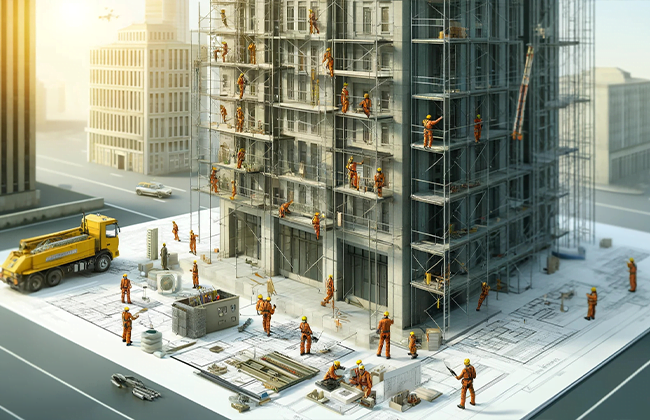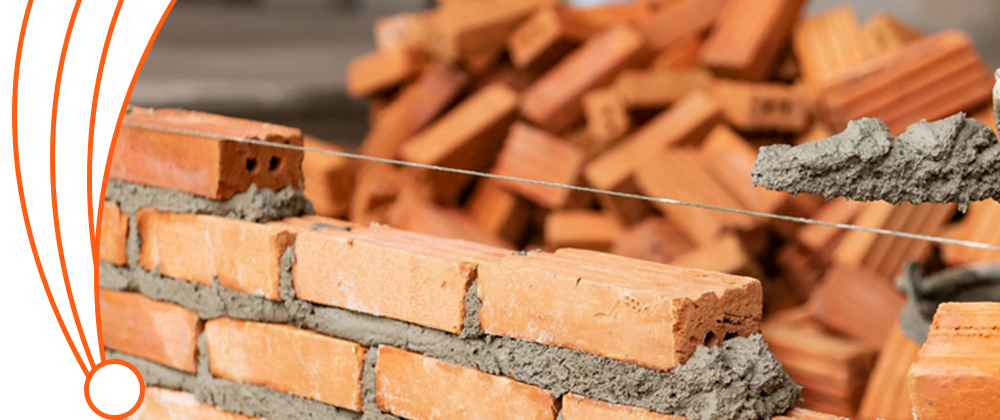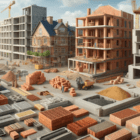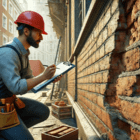Local Law 11 requirements are essential for building owners in densely populated urban areas, ensuring that their high-rise structures are safe and well-maintained. This law mandates periodic inspections of building facades to identify and rectify potential safety hazards, protecting both the public and property. Adhering to Local Law 11 requirements not only enhances building integrity but also complies with city regulations, preventing potential legal and financial repercussions.
Table of Contents
What is Local Law 11?
Local Law 11, also known as the Façade Inspection Safety Program (FISP), was implemented to tackle the safety risks associated with the exteriors of buildings in densely populated urban settings. The regulation mandates that all buildings exceeding six stories must undergo rigorous façade inspections every five years. These critical assessments are carried out by qualified exterior wall inspectors (QEWIs), who are generally licensed architects or engineers. The primary aim of this law is to prevent accidents and ensure public safety by identifying potential structural failures before they can pose a threat.
Understanding the Inspection Process for Local Law 11
Local Law 11’s inspection process is meticulously designed to ensure the safety of high-rise buildings in urban environments. Here, we’ll break down the steps involved in this crucial procedure:
1. Initial Documentation
The first step for building owners under Local Law 11 is to compile and submit all necessary initial documentation. This includes comprehensive building plans that show the current layout and structural details of the facade. Additionally, any reports from previous inspections need to be included. This documentation serves as a baseline for the qualified exterior wall inspector (QEWI), providing them with the necessary context to understand the building’s history and specific areas that may require closer examination.
2. Physical Inspection
Next, the QEWI conducts a thorough physical inspection of the building’s exterior. This inspection is not just a cursory glance at the surface; it involves a detailed examination of all external elements including walls, windows, balconies, and terraces. The inspector looks for any signs of deterioration, structural weaknesses, improper installations, or any other conditions that might compromise the building’s safety. They often employ tools like drones, binoculars, or even scaffoldings to get a close look at hard-to-reach areas. Every flaw, no matter how small, is documented to ensure nothing is overlooked.
3. Report Filing
After completing the physical inspection, the QEWI prepares a detailed report outlining the condition of the building’s facade. This report is crucial as it provides a definitive record of the building’s status and is filed with the Department of Buildings. The report categorizes the building as:
- Safe: indicating the facade is in good condition and poses no immediate hazards.
- Unsafe: highlighting urgent facade issues that need immediate rectification to prevent potential hazards.
- Safe with a Repair and Maintenance Program (SWARMP): noting conditions that are not currently hazardous but will require repair or maintenance within a specified timeframe to prevent future risks.
This comprehensive reporting ensures that the building owner receives full information about the condition of the building and can take appropriate actions based on the provided categorizations. It also acts as a regulatory compliance document that the owner must adhere to in order to avoid penalties and ensure public safety.
Through each step of this process, Local Law 11 aims to maintain the structural integrity and safety of buildings, thereby protecting both the residents within and the public around these high-rise structures. Compliance with this law not only helps in safeguarding lives but also plays a crucial role in maintaining the aesthetic and functional standards of urban architecture.
Compliance and Penalties Under Local Law 11
Adhering to Local Law 11 is crucial for building owners in urban areas, particularly because non-compliance can lead to significant repercussions. Let’s delve into what compliance entails and the penalties for failing to meet these standards.
Understanding Compliance
Compliance with Local Law 11 involves not only conducting the required inspections within the stipulated timelines but also addressing any issues identified during these inspections. Buildings classified as unsafe or SWARMP (Safe With A Repair and Maintenance Program) need prompt attention to bring them up to code. Building owners prove compliance by filing detailed reports with the Department of Buildings and executing any necessary repairs or preventive measures recommended in these reports.
Penalties for Non-Compliance
If a building owner neglects to comply with Local Law 11 requirements, they can face steep penalties. These are not just monetary fines but can also include legal actions that complicate a building owner’s responsibilities. For example:
- Fines: The city can impose daily fines that accumulate until the compliance issues are resolved. These fines can be substantial, often running into thousands of dollars, depending on the duration and severity of the non-compliance.
- Legal Actions: In cases where non-compliance leads to accidents or hazards, building owners might face lawsuits or other legal proceedings. These can result not only in financial losses but also damage to the reputation of the property and its management.
Implementing Safety Measures
For buildings identified as unsafe, immediate measures must be taken to protect the public. This often involves the installation of sidewalk sheds or scaffolding to prevent falling debris from causing injuries or property damage. Such measures are not only a legal requirement but also a critical step in safeguarding pedestrians and nearby properties while repair work is underway.
Proactive Steps to Avoid Penalties
To avoid these penalties, building owners should:
- Schedule Regular Inspections: Keep track of inspection dates and ensure a certified inspector conducts them on time.
- Address Issues Promptly: Address any problems identified during an inspection immediately to prevent them from escalating into unsafe conditions.
- Keep Detailed Records: Maintain thorough records of all inspections, reports, and repairs as proof of compliance and to facilitate future inspections.
Understanding and complying with Local Law 11 is not just about avoiding penalties but also about ensuring the safety and integrity of buildings. By taking these regulations seriously, building owners contribute to a safer urban environment for everyone.
Preparing for Inspection Under Local Law 11
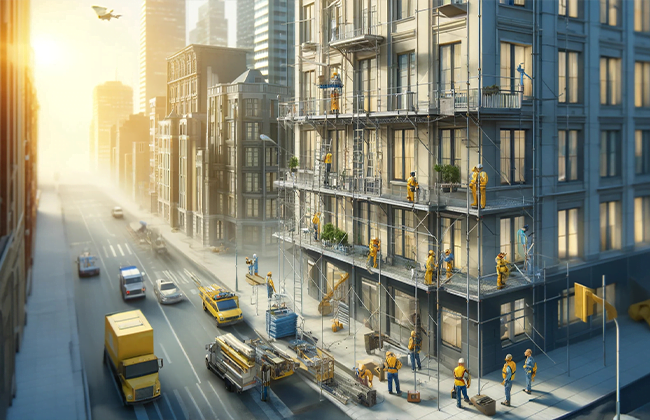
For building owners, preparing for a Local Law 11 inspection is crucial to ensure a smooth process and minimize the risk of violations. Here’s how owners can effectively prepare for these important inspections:
Ensuring Accessibility
One of the first steps in preparation is to make sure that all areas of the building’s facade are easily accessible to inspectors. This might involve removing obstacles or temporary structures that could block parts of the exterior. Accessibility is key, as inspectors need to conduct a thorough check of the entire facade, including hard-to-reach areas like high corners, rooftops, and balconies.
Addressing Known Issues
Before the inspection, it’s wise for building owners to address any known issues with the facade. This could include repairing loose bricks, sealing cracks, or fixing any leaks. By resolving these issues beforehand, owners can potentially avoid citations for violations. It’s about taking proactive steps to ensure that the building not only meets the regulatory standards but also maintains its structural integrity.
Consulting with Experts
Often, building owners benefit from consulting with architectural experts or engineers prior to the inspection. These professionals can provide valuable insights into what inspectors look for and can help identify potential problem areas that a non-expert might miss. They can also assist in prioritizing repairs based on urgency and compliance requirements.
Documenting Pre-Inspection Repairs
It’s important for owners to keep detailed records of any repairs and maintenance work done in preparation for the inspection. This documentation should be thorough, including dates, the nature of the work, and details of the contractors involved. Such records can be invaluable during the inspection to demonstrate compliance and proactive management of the building’s facade.
Regular Maintenance
Finally, regular maintenance is crucial. Building owners should not wait for the inspection cycle to conduct repairs and upkeep. Regular maintenance ensures that the building stays in good condition and complies with safety standards year-round, reducing the chance of discovering major issues during the official inspection.
By following these steps, building owners can effectively prepare for Local Law 11 inspections, ensuring their buildings are safe, compliant, and less likely to incur violations. This proactive approach not only helps in maintaining the structural health of the building but also contributes to the safety and well-being of its occupants and the public.
Maintenance Strategies after Inspection
After completing a Local Law 11 inspection, developing a thorough maintenance strategy is critical to ensuring long-term building safety and compliance. Here’s how building owners can effectively manage their maintenance efforts based on the inspection findings:
Developing a Maintenance Plan
Once building owners receive the inspection report, they must carefully review the findings and create a detailed maintenance plan. This plan should prioritize repairs based on the severity of issues identified during the inspection. For instance, any structural threats that could pose immediate risks to safety should be addressed first.
Scheduled Repairs
The maintenance strategy should include a schedule for repairs. This schedule needs to be realistic and allow for timely correction of all issues noted in the inspection report. Setting clear timelines ensures that you not only complete the repairs but also do so in a way that prevents future violations during subsequent inspections.
Ongoing Monitoring
In addition to scheduled repairs, ongoing monitoring of the building’s facade is crucial. Building owners should regularly inspect their properties for new or worsening conditions that were previously identified. This proactive surveillance helps catch and address minor issues before they evolve into significant problems.
Implementing Preventive Measures
Preventive maintenance is as important as corrective actions. Building owners should implement measures that help prevent common facade problems. This could include improving water drainage systems to avoid water infiltration, which can lead to structural damage, or applying sealants to protect exposed areas from weather-related deterioration.
Training and Educating Staff
Building owners should also consider training their maintenance staff on the specific needs of the building’s facade. Educated staff can be invaluable, as they are often the first to notice potential issues. Regular training ensures they know how to properly monitor the facade and understand the signs of potential problems.
Documentation and Record Keeping
Keeping detailed records of all maintenance activities is vital. These records should include dates of repairs, the nature of the work completed, details of contractors or services used, and any costs incurred. Good record-keeping not only aids in managing the building’s maintenance cycle but also provides essential documentation for future inspections.
By integrating these strategies, building owners can ensure their buildings remain in good condition and compliant with Local Law 11 requirements. This approach not only safeguards the structural integrity of the property but also enhances the safety of its occupants and the general public.
Case Studies and Best Practices
Examining specific instances where compliance and non-compliance with Local Law 11 played a crucial role can offer valuable insights. Here’s a closer look at some case studies and best practices that highlight the importance of adhering to these regulations:
Case Study: Lower Manhattan Incident
In Lower Manhattan, a building owner faced significant fines after failing to comply with Local Law 11. Debris from the building’s facade fell onto a busy sidewalk, causing injuries to pedestrians. This incident was a direct result of neglected facade inspections and maintenance. The building received several prior warnings for potential facade issues that it did not adequately address, leading to this preventable accident. This case underscores the critical nature of regular inspections and the immediate rectification of identified issues.
Best Practices for Compliance
To avoid such incidents and ensure safety, building owners can adopt several best practices:
- Regular Inspections: Even outside the mandatory inspection schedule, it’s prudent for building owners to conduct periodic reviews of their building’s facade. This helps in identifying potential problems early on.
- Immediate Repairs: Upon finding any facade deterioration or damage, immediate action should be taken to repair these issues. Delaying repairs can lead to accidents, as seen in the Lower Manhattan case.
- Use of Qualified Professionals: When you hire experienced and qualified professionals for both inspections and repairs, you ensure that they complete the work correctly and to the required standards. This also increases the likelihood of catching and resolving potential problems efficiently.
- Implementing a Maintenance Schedule: Establishing and sticking to a comprehensive maintenance schedule can prevent the escalation of minor issues into serious problems. This includes regular cleaning, checks for water damage, and the repair of minor cracks and wear.
- Educational Workshops for Staff: Conducting workshops and training sessions for all staff involved in building maintenance can raise awareness about the importance of facade safety and compliance with Local Law 11.
Learning from Past Mistakes
Another case involves a building in Brooklyn where delayed facade repairs after an inspection led to partial facade collapse. Fortunately, no one was injured, but the incident temporarily displaced residents and caused legal troubles for the building owner. This incident further illustrates the importance of timely response to inspection findings.
Documentation and Transparency
Maintaining transparent and detailed records of all inspections, repairs, and maintenance activities is essential. These records should be easily accessible and updated regularly. They not only help in managing the building’s maintenance more effectively but also provide necessary documentation in case of legal scrutiny or insurance claims.
By learning from these case studies and implementing best practices, building owners can ensure they remain compliant with Local Law 11, thereby enhancing the safety and integrity of their buildings and protecting the well-being of the public. This proactive approach not only fulfills legal obligations but also contributes to the overall longevity and value of the property.
Future Implications and Updates
Local Law 11, crucial for maintaining the structural safety of buildings, is dynamic and adapts over time to new safety standards and technological advancements. Here’s what building owners need to know about staying updated with these changes and preparing for future implications:
Keeping Up with Updates
Local Law 11 is regularly reviewed and updated to incorporate the latest safety practices and technologies. For instance, recent revisions may include more stringent inspection criteria or the introduction of new materials and techniques for facade repair. Building owners must stay informed about these changes. Subscribing to updates from the local building department or joining relevant industry associations can be effective ways to keep abreast of these developments.
Technological Advancements
Advancements in technology also impact how inspections and repairs are conducted. For example, the use of drones for facade inspections has become more prevalent, allowing for more detailed and safer inspections without the need for scaffolding. Building owners should consider how such technologies might be leveraged to comply with Local Law 11 more efficiently.
Training and Education
As standards evolve, the need for continuous education becomes more critical. Building owners and their maintenance teams should participate in training sessions and workshops to understand the latest requirements and inspection techniques. This ensures that they not only comply with current regulations but are also prepared for any new changes that may be introduced.
Long-term Compliance Strategies
To ensure ongoing compliance, building owners should develop long-term strategies that anticipate future changes to the law. This might involve setting aside a budget for regular updates to inspection tools and repair techniques. It might also mean scheduling regular consultations with legal and engineering experts who specialize in urban building regulations.
Engagement with Regulatory Bodies
Active engagement with regulatory bodies and participation in public discussions about building safety regulations can provide building owners with insights. These insights can reveal potential future changes in the law. This proactive approach enables them to prepare in advance instead of scrambling to adapt once new regulations are enacted.
Documentation and Record Keeping
Keeping comprehensive records becomes even more important as regulations change. Detailed documentation of all inspections, repairs, and correspondence with regulatory authorities can protect building owners. This is crucial in the event of disputes or litigation. It also simplifies compliance with new amendments to the law.
By staying informed about updates and preparing for future changes, building owners can ensure that their buildings remain safe and compliant. They can also stay ahead of the curve in terms of building safety standards. This not only enhances the safety and longevity of the property. It also contributes positively to the broader community by ensuring public safety and confidence in urban infrastructure.
Conclusion
Adhering to Local Law 11 requirements is crucial for the safety and integrity of buildings in urban environments. These regulations help prevent potential hazards by ensuring that all buildings meet strict safety standards through regular inspections and maintenance. If you’re a building owner needing professional assistance with Local Law 11 compliance, feel free to contact us at (+1) 917-355-8556. We offer expert services tailored to meet these critical safety standards.
FAQs
Q: What are the key Local Law 11 requirements for building inspections?
A: Local Law 11 requirements stipulate that buildings taller than six stories must undergo exterior facade inspections every five years. This ensures structural safety and compliance with city safety standards.
Q: How often must building owners comply with Local Law 11 requirements?
A: Building owners must conduct facade inspections every five years to comply with Local Law 11 requirements. They must promptly address any identified issues to maintain the building’s safety integrity.
Q: Who is qualified to conduct inspections under Local Law 11 requirements?
A: Qualified exterior wall inspectors (QEWIs), typically licensed architects or engineers, have the authorization. They perform inspections as per Local Law 11 requirements.
Q: What happens if I fail to meet Local Law 11 requirements?
A: Failure to meet Local Law 11 requirements can result in significant fines. It can also lead to mandatory safety measures and possibly legal action. This depends on the severity and nature of the non-compliance.
Q: Can changes in Local Law 11 requirements affect my existing building?
A: Yes, changes in Local Law 11 requirements can impact all buildings subject to the law. Owners must stay updated with new standards. They must ensure their properties comply with current regulations.

